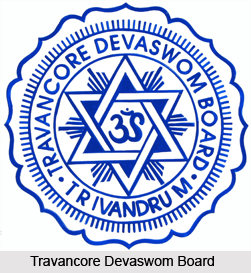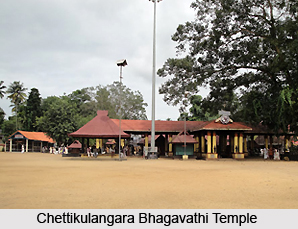About Devaswom
Devaswom is a social system that is found in Kerala where almost all temples are either managed by Government controlled Devaswoms or formed by private bodies or families. All temples of Kerala are managed by Devaswoms. Devaswom means properties of god. Under this system all properties of each temple are declared as personal property of presiding deity and managed through a body of trustees who the worshippers of the presiding deity.
According to Travancore-Cochin Hindu Religious Institutions Act-1950, State Government of Kerala is responsible for managing all temples except owned by those private families and private boards. Only Government appointed Devaswom officials and board interfere in the affairs of the temple. All Devaswom board members as well as officials are Hindus and sworn to prime deity of each Devaswom Board. The state of Kerala also has a Devaswom Minister who is in charge of all Devaswom related affairs.

History of Devaswom describes the creation of Devaswoms by the families of Nampoothiri Brahmins, during the latter part of the 17th century and before this, Rajaswoms or Brahmaswoms were intrinsically connected to the temples. During the 15th and 16th centuries, Kerala witnessed extreme form of fragmentation into tiny feudal states and this instigated the Rajaswoms and Brahmaswoms to emerge all the more powerful which automatically led to political disturbances. In order to curb the power of the Brahmaswoms and Rajaswoms, the `Zamorins` and other powerful families introduced Devaswoms. These were perceived as neutral bodies that were governed by a group of trustees who were elected by the state. However it could be changed by a royal decree. The first ruler to implement this was `Samoothiri`. He curbed the powers of Malliserri Mana who ruled the Brahmaswom of Guruvayoor. Samoothiri Raja Mana Vikram annexed the temple and appointed a body of trustees which included the Chief of Malliseeri Mana as well as other leading local Namboodiri and Nair families. Many other regional temples of Kozhikode also soon followed this policy.
In the year 1762, when the political power of Zamorin over the area of Cochin finally concluded, the ruler of Cochin started seizing a majority of temples which were ruled by the Nairs and Namboodiris and they were said to be favourable inclined towards the Zamorin. The properties of Yogaathiri (with Nampoothiri trustees) and `Ooraalaars` (Nair trustees) were confiscated. The temples managed by them came under the administrative control of the state. The royal Government had captured most of the local temples present in Cochin and they were all transferred to the newly developed Devaswoms which had acknowledged the sovereignty of the king and also the deity. Travancore governments since then implemented a policy of slow annexations of private temples and their assets and forming Devaswoms for each temple.
Colonel Munroe, who was appointed in 1812 as Diwan of the Cochin and Travancore kingdoms recommended that all Devaswom properties be treated as government properties. He also made it a rule that the revenue which would be generated from Devaswom must be counted as the general revenues of the entire state. All such regulations were freely accepted by the Maharajas of the region of Cochin and also Travancore, and a separate committee was created in the year 1815 to analyze its characteristics. A royal decree was passed during the reign of Gowri Parvati Bayi wherein a Devaswom Board was developed and a majority of the local temples of Travancore were transferred to its control. They declared their loyalty to the Travancore Devaswom Board.
Following a detained study of 179 Devaswoms and 309 Devaswoms of Cochin were categorized as `Sarkkar Devaswoms`. As many as 61 Devaswoms were returned back to Ooraalaars and yet series of 61 were categorized as `Vazhipaat Devaswoms`. The above action was an important step by the State Government. Consequently, the lands of the temples were acquired by the State and they were empowered to infringe in the administration of temples. Of these temples, 179 temples were referred to as `incorporated Devaswoms` and 24 were known as `Keezhetams`. The Sarkkar confiscated more temples owing to poor temple management by the Ooralaars or some or the other pretext. Every Devaswom was termed as `unincorporated Devaswom`. The Government started controlling the management of the Devaswoms which were not supervised efficiently, according to the Cochin Hindu Religious Institutions Act of 1896. These organizations came to be known as `assumed Devaswoms`.
A distinct Devaswom Department was created in the year 1897 under all the registered and non-registered Devaswoms which were all governed by a superintendent. In 1907, they were all joined together and much later a common trust fund was developed following an amendment of 1916. On 1st November, 1926, the head of the department of Travancore and Cochin were offered the posts of commissioner. The administrative power of the Devaswoms present in the state of Cochin slipped into the administration of the Cochin Devaswom Board or CDB which was developed on 1st August, 1949. Both the groups of Devaswoms were brought under the Board by the Travancore - Cochin Hindu Religious Institutions Act of 1950. The Board was reorganized on 16th June, 1950. The temples which are the recipients of grants and funds from Devaswom Boards which are controlled by different states are termed as `Vazhipaat Devaswoms`.
Devaswom Board
 The Devaswom Board comprises of President and two Members. The President and one Member are nominated by the Hindu members of the Kerala Council of Ministers and the other Member from the Hindu Members of State legislature. The term of the President and Members is for a period of four years. The head quarter is located in Thiruvananthapuram. Travancore Maharaja is considered as the patron of all temples owned by Travancore Devaswom Board
The Devaswom Board comprises of President and two Members. The President and one Member are nominated by the Hindu members of the Kerala Council of Ministers and the other Member from the Hindu Members of State legislature. The term of the President and Members is for a period of four years. The head quarter is located in Thiruvananthapuram. Travancore Maharaja is considered as the patron of all temples owned by Travancore Devaswom Board
Temples that are under Travancore Devaswom board
Some of the main temples that are under Travancore Devaswom board are:
Sri Dharmasastha Temple, Pathanamthitta
Chettikulangara Bhagavathi Temple, Mavelikkara
Vazhappally Maha Temple, Changanassery
Aranmula Sree Parthasarathy Temple, Pathanamthitta
Sree Vallabha Temple, Thiruvalla
Mahadeva Temple, Chengannur
Anjaneya Temple, Kaviyoor
Sreekrishna Temple, Ambalappuzha
Mahadeva Temple, Kandiyoor, Mavelikkara
Mahadeva Temple, Eattumanoor
Sreekrishna Temple, Mavelikkara
Mahadeva Temple, Vaikom
Devi Karthiyayani Temple, Cherthala
Mookambika Devi Temple, North Paravur
Narasimha Moorthy, Sudharshana Moorthy Mahakshethram, Thuravoor
Devi Karthiyayani Temple, Aroor, Alapuzha
Sree Subhramanya Temple, Harippad
Malayalappuzha Devi Temple, Pathanamthitta
Thirunakkara Siva Temple, Kottayam
Sreekanteswaram Temple, Thiruvananthapuram
Sree Parasurama Swamy Temple, Thiruvallam, Trivandrum
Mahadevar Temple, Kazhakkuttom, Trivandrum
Sarkara Devi Temple, Chirayinkil, Trivandrum
Kodungoor Devi Temple, Kodungoor, Kottayam
Agasthyacode Mahadevar Temple, Agasthyacode, Anchal, Kollam
Major Puthiydam Sreekrishna Swami Temple, Kayamkulam
mahagnapathi temple , kottarakara
vettikalavala temple vettikavala
ayyapaswamy temple, kulathupuzha
ayyapaswamy temple, ayankavu
ayyappaswamy temple, achankovil
sastha temple, sasthamcotta
padanayarkullanagara temple, karunagapply
kotttamkullanagara devi temple ,chavara
janardhana swamy temple, varkala
Temples that come under Cochin Devaswom Board
Some of the main temples that come under Cochin Devaswom Board are:
Rajarajeshwari Temple, Chottanikkara, Ernakulam
Shree Poornathrayeesha Temple, Thripoornuthura, Ernakulam
Shiva Temple, Ernakulam
Elangunnapuzha Temple, Vypin
Kodungallur Bhagawathi Temple, Kodungallore
Pazhayannur Bhagawathy Temple
Peruvanam, Thrissur
Arrattupuzha, Thrissur
Vadakkumanathan Temple, Thrissur
Sreeramaswamy Temple, Triprayar
The Guruvayur Devaswom Board was formed for looking after the administration of the activities of Guruvayur Temple.



















